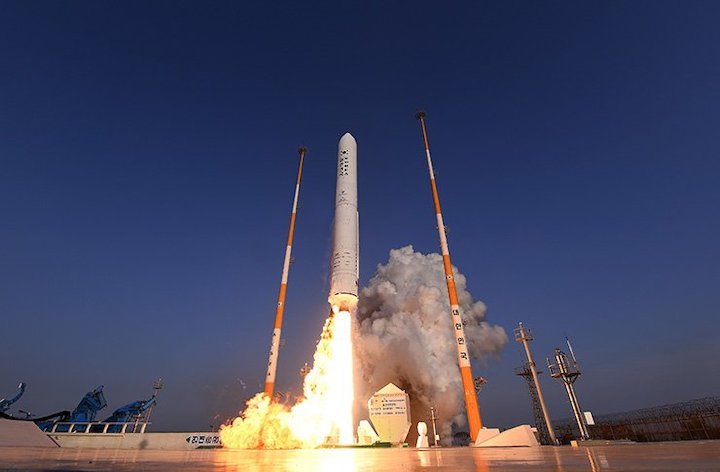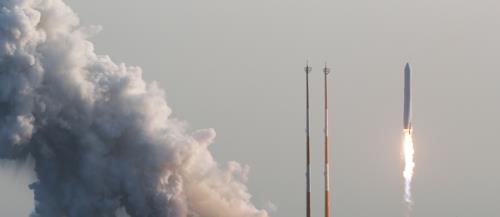29.11.2018

Korea successfully test-launched a first-stage rocket booster powered by a domestically developed engine, Wednesday, paving the way for the development of the nation's first space vehicle entirely designed and built in the country.
The 75-ton-thrust engine was fired up and launched the first-stage rocket at the Naro Space Center in Goheung, South Jeolla Province, at 4 p.m., as part of the country's long-term project to launch the Korea Space Launch Vehicle-2 (KSLV-2), dubbed Nuri, in 2021.
The Ministry of Science and ICT said it achieved an engine burn-time of 151 seconds, which exceeded its goal.
It earlier said the test launch would be considered a success if the engine maintained a burn-time of about 140 seconds.
The test rocket also reached a maximum altitude of 209 kilometers, 319 seconds after liftoff, and safely landed in international waters southeast of Jeju Island.
The ministry and the Korea Aerospace Research Institute (KARI) verified the engine's performance and flight control systems during the test.
"Through the test launch today, we confirmed that technical preparations for the development of the KSLV-2 are going smoothly. We will have our own space vehicle in 2021," said a ministry official. "We applaud the efforts of researchers of KARI and other experts who have participated in the development."
The ministry noted it will further analyze data from the test to confirm details of the performance of the engine, adding the government will continue to give its efforts to develop space technologies that will contribute to the nation's economic growth.
The test rocket was transported to the launch pad, Tuesday.
Officials of the ministry and the KARI held a meeting later that day and checked the results of a rehearsal.
The ministry and KARI had initially planned to conduct the first test-flight, Oct. 25, but this was delayed due to mechanical problems.
At the time, the ministry said problems arose in the rocket propellant pressurization system.
The three-stage KSLV-2 rocket is scheduled to be launched in 2021, with four Korea-developed booster engines being used in the first stage and one in the second stage.
If successful, the KSLV-2 will be used to place unmanned satellites in orbit and for other commercial applications.
Quelle: The Korea Times
+++
S. Korea successfully tests space rocket engine
GOHEUNG, South Korea, Nov. 28 (Yonhap) -- South Korea successfully tested its locally developed rocket engine on Wednesday, officials said, taking a step closer to the full-fledged development of the country's first space launch vehicle.
The test of the 75-ton thrust engine was conducted using a single-stage rocket that was launched from the Naro Space Center in Goheung, South Jeolla Province, at 4:00 p.m.
The rocket engine, designed and developed by the Korea Aerospace Research Institute (KARI), will be used on the three-stage Korea Space Launch Vehicle-2 (KSLV-2) currently under development.
The 75-ton thrust engine is considered a core technology behind the KSLV-2, which would make South Korea the seventh country in the world to build a space launch vehicle with homegrown technology.
The Ministry of Science and ICT and KARI said the critical rocket motor combustion time was maintained for 151 seconds, surpassing an initial goal of 140 seconds.
KARI said evaluating the performance of a liquid propellant rocket engine is determined by the length of the total combustion time.
The rocket flew for about 10 minutes after reaching a maximum suborbital altitude of 209 kilometers and hit the ocean 429 kilometers southeast of the country's southern resort island of Jeju.


